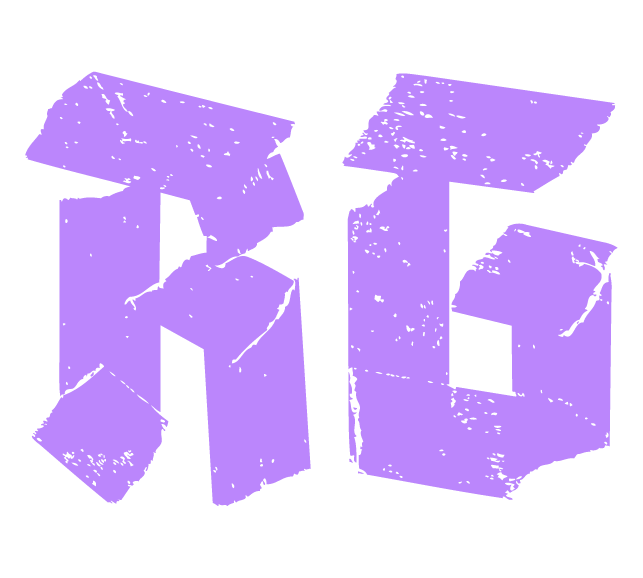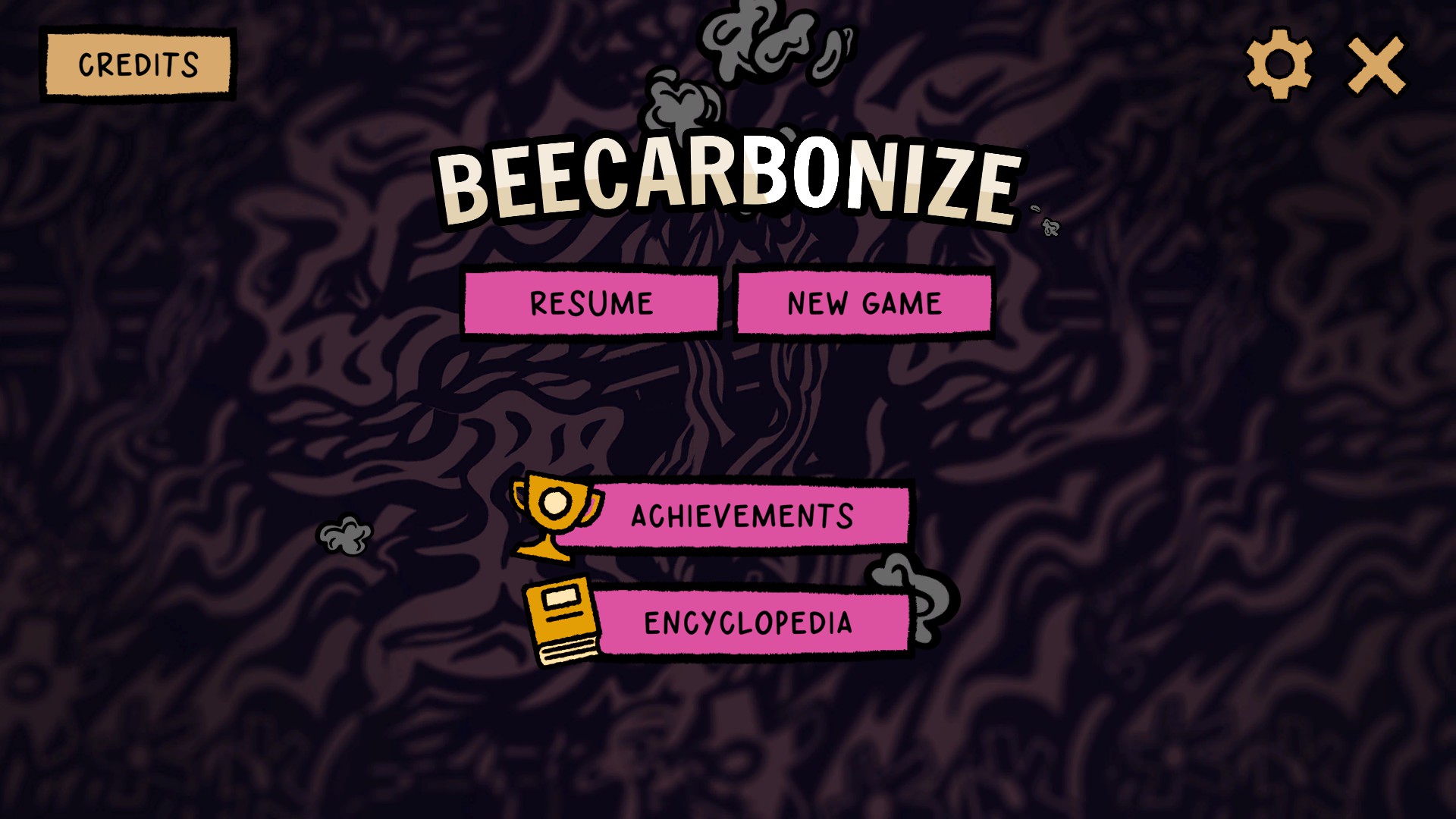As a fan of tabletop games, there was a moment in time in which I was on a spree of playing card based digital games, trying out various games such as Inscryption and Stacklands. Around the same time, I was scrolling through Steam’s new releases and came across a game that looked like it would scratch that itch – so I added it to my library and promptly forgot it ever exists. That game is Beecarbonize – a free to play, card-based resource management game which I’ve finally gotten around to installing this week.
The game markets itself as a complex simulation running an “environmental card strategy game with climate change as your opponent.” For the sake of this review, I’m going to break it down into two components – the gameplay itself, and the concept of this game as an artform or social commentary – as I feel it has its own strengths and weaknesses in each department, however, right off the bat I don’t believe it necessarily does a great job of connecting the two.
Starting off with the gameplay, the core loop is fairly simply. You have a table or board broken down into two four sections in which you can play cards, a fifth section in which environmental disaster cards are placed by the game, and a meter that keeps track of your total emissions throughout the game. The game runs a time cycle, and every cycle will produce – or reduce – resources and emissions. The four sections in which you manage your cards are broken down into four categories:
- Industry
- Ecosystems
- People
- Science
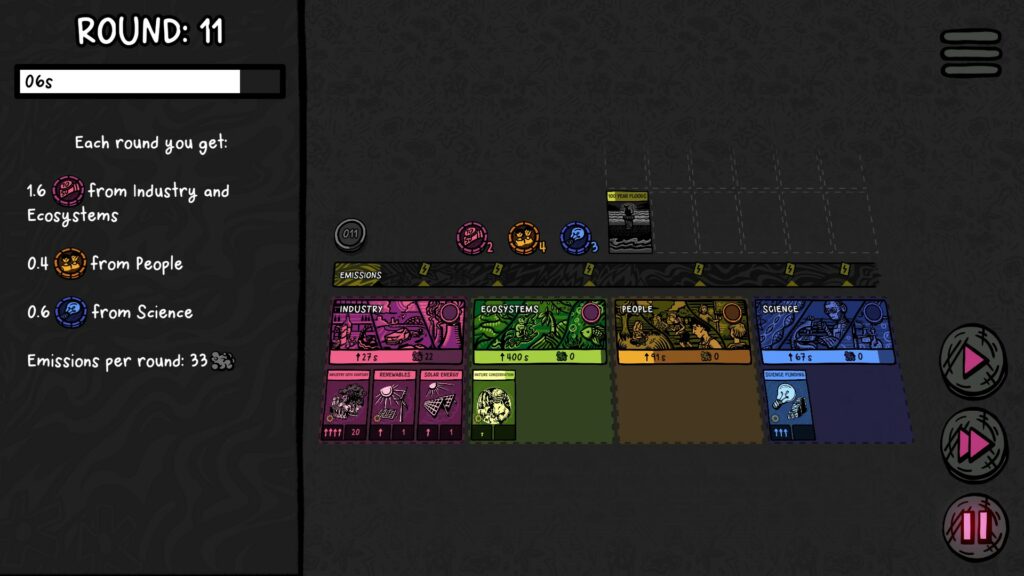
Additionally, there are three types of resources shown as various tokens. As the game doesn’t name them explicitly, for the same of this review ill refer to the purple tokens as currency, the yellow tokens are population, and the blue tokens are science points. These tokens are primarily used to construct new cards and remove disaster cards.
Each section has a timer at the bottom of its thumbnail which shows how much longer it takes until its specific resource is generated, along with how the value of emissions that will be generated along side it. Cards can be placed in each area to either increase or decrease the time it takes for a cycle to occur in that field and the total number of emissions that card creates/removes.
Each card contains arrows in the bottom left corner representing the time modification, and a positive or negative number representing the emissions.
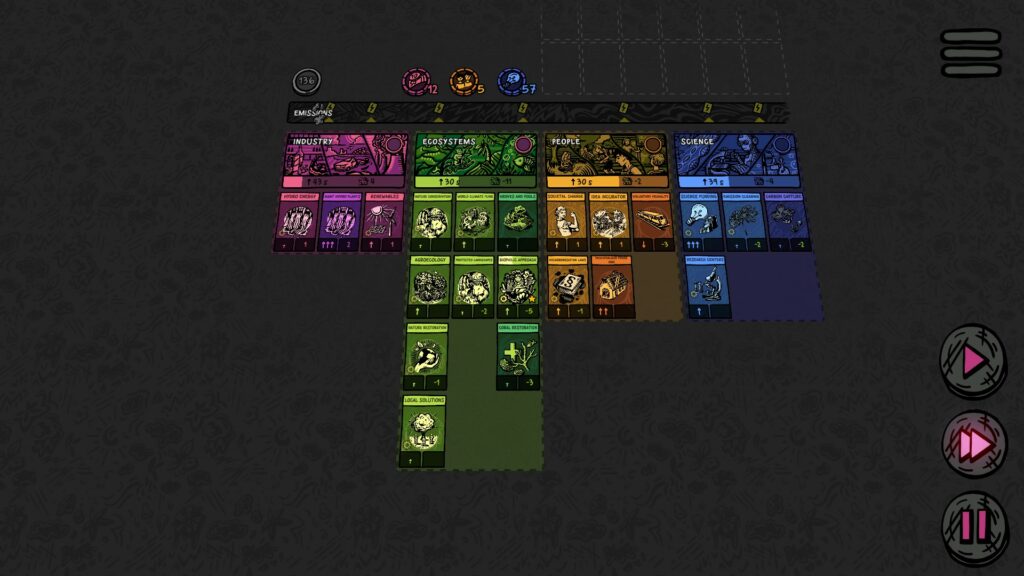
Industry and Ecosystems are the two sections that both produce currency, however, they differ in their cards’ playstyle. Industry cards can be used to produce currency very quickly while also creating heavy emissions; whereas ecosystem cards produce currency much slower, however either create minimal emissions, or outright remove emissions from your total meter. The game begins with a single card in the industry section.
The people section cards will increase your population; however, with each population token gain, a currency token is consumed. If you produce a population token and have no currency to consume a “starvation” disaster card is generated which can lead to the end of your run if not addressed. Cards in this section either marginally increase or decrease emissions.
The science section cards produce science points – an alternative currency simply used to construct some cards. They generally produce minimal emissions; however, their initial construction may remove a certain number of your total emissions.
Lastly, the global disaster section is not managed by the player, but by the game itself. Periodically, disaster cards will appear which have their own time cycles. At the end of each cycle, the player is negatively impacted – either by having cards destroyed, having emissions added to the total pool, or ultimately ending the current run. Players can remove these disaster cards by clicking on them and opting to pay the required resources to remove them.
Each card functions as a tech-tree of its own; once built, players can click on the card and select various options of new cards to build. The majority of cards simply modify timers and emissions while as stated in the science section, they may have a one-time benefit upon construction that will remove a certain number of total emissions from the game.
The goal of the game is to build one of 6 possible end-game cards that will result in victory once they are on the board. However, while working through the various tech trees, players must balance their resource production with their emissions production. There are points along the meter which signify “environmental tipping points” and once the meter reaches these points a unique disaster card is generated, some of which can result in a game-over.
As there are 6 possible victory cards to build towards, the game allows players to experiment with various strategies and play styles. However, this is where I feel the game suffers. Despite there being various ways to play, there is ultimately a dominant strategy. Firstly, cards can be discarded by removing them from their specific area; as such, I’ve found on various playthroughs that the clear path to victory is simply letting the game play itself for a few cycles with the starting card in play, then discarding it to focus on ecosystem cards. This is due to the mechanics where ecosystem cards function as slightly weaker industry cards, however, prevent the player from reaching tipping points by having little impact on emissions. Furthermore, the people section can be a hinderance to the player as each cycle in this section will consume currency. As such, this section can be mostly ignored until later into your run to avoid creating starvation cards. Lastly, science cards seem like an interesting alternative to victory, however, you can get by with hardly touching this section. Overall, I believe there are some balancing issues with the game.
On the topic of balancing issues, I believe the developers are also aware of this as one of the game’s optional achievements is to build a victory card while keeping the starting industry card in play the entire run. Rather than addressing the broken nature of this dominant strategy (removing the starting card), they simply made it a one-time challenge to beat the game while holding on to it.
Overall, in terms of gameplay, I don’t believe the game is bad by any means, however, I found that it quickly loses its appeal. I’ve gone through multiple runs and achieved victory by various means; however, when it came down to my emissions getting out of hand, I was always able to simply remove some industry cards and offset them with ecosystem cards. By doing so, I could always let the game play itself for a few rounds where the ecosystem cards reduce my total emissions with no true repercussions. In terms of gameplay I find this limits the game’s fun, but in regards to the narrative and social commentary of the game, it paints an interesting picture.
Ultimately, as a free to play game Beecarbonize’s central focus seems to be its educational nature, rather than a focus on gameplay and mechanics – as such, I would argue that it functions more as a piece of interactive art rather than a long lasting, replayable game.
Shifting gears from game-design analysis of Becarbonize, I would also like to comment on the game’s overarching theme and narrative. In this aspect, I believe the game successfully educates the player on topics surrounding climate change, the possible effects on our planet and various strategies to combat it. Starting the player off with a single card within the industry section – one that produces currency quickly while also rapidly increasing global emissions – details how the industrial revolution was the first key event in human history that begun the downward spiral we’re currently experiencing. Furthermore, the first tipping point in the game – “warming of 0.5 – 1.0 *C – is nearly impossible to avoid, which further solidifies the statement on the industrial revolution.
As stated earlier, a dominant strategy in this game is to limit the number of cards in the industry section and attempt to gain currency with as many ecosystem cards as possible. Although it may take many more turns – which can be seen as an analogy to time or years – it is ultimately possible to produce currency as effectively through ecosystem cards as it was at the start of the game using the industry cards. I believe the game designers are making a statement that, despite requiring more investment, the world can run as efficiently through green energy, while also limiting or even reducing global emissions.
Furthermore, while it is possible to reduce the total emissions meter to zero, any tipping points reached throughout the game will persist and negatively impact the run through random environmental disaster events. This stands as a strong analogy. Although we can address climate change and change our ways, permanent damage to our planet has already been done. As such, we should strive to prevent further damage while acknowledging our past mistakes as a global society.
Another key system within the game is the encyclopedia section. This section is empty upon installing the game, however, each card discovered throughout your runs can be later found in this menu. From here, players can select the previously discovered cards and learn more about each topic. For example, see the image below detailing the “Loss & Damage Aid” card:
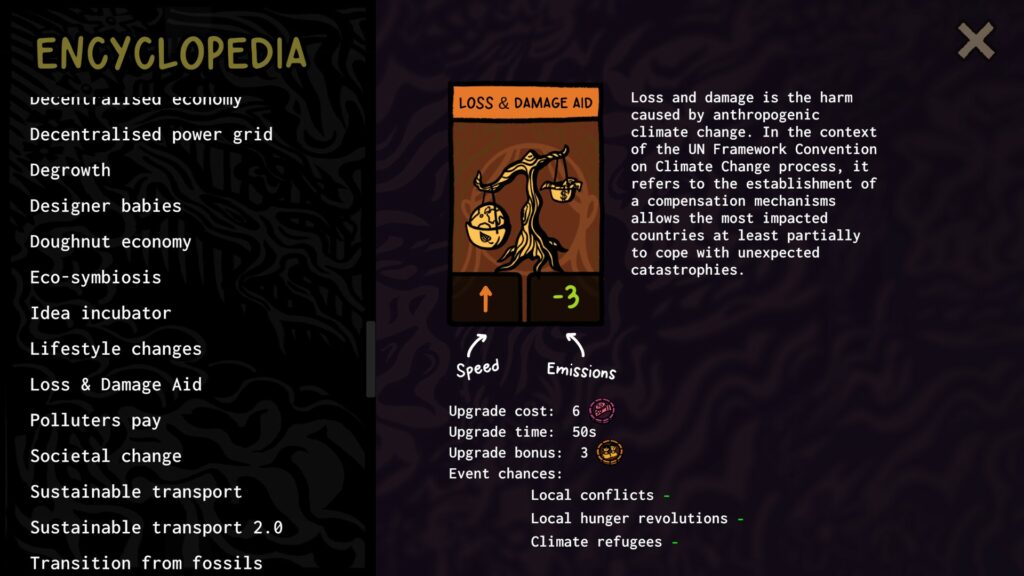
Players can also select cards mid-game when they are first discovered and choose to view the details at this. Personally, I believe this break gameplay loop but may benefit a player’s immersion as they are provided context to their actions and decisions.
My only criticism of the social commentary of Beecarbonize would relate to a few of the societally “beneficial” cards. Personally, I believe some of these a truly dystopian and am conflicted on the idea of them being good for society. Take for example the “VR Utopia” card which reduces the chances or receiving events such as “Local conflicts” and “mass protests”:
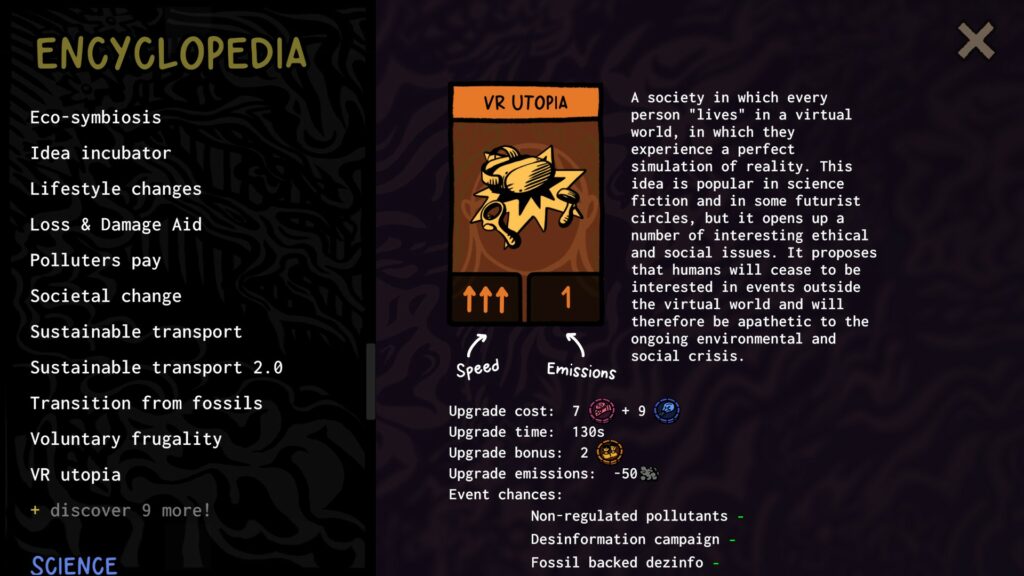
Ultimately, I can’t see myself ever returning to Beecarbonize. The few hours I’ve spent with this game have given me more than my fill. Nonetheless, I believe it functions well as a piece of interactive art that can be a fun way to introduce people to the topics surrounding climate change. Purely from a gameplay standpoint, I wouldn’t recommend this game; however, putting these critiques aside I will say that it could be an engaging way to familiarize yourself with new ideas for a couple of hours – especially for a younger audience. As the game is free, there’s no harm in trying it out.
